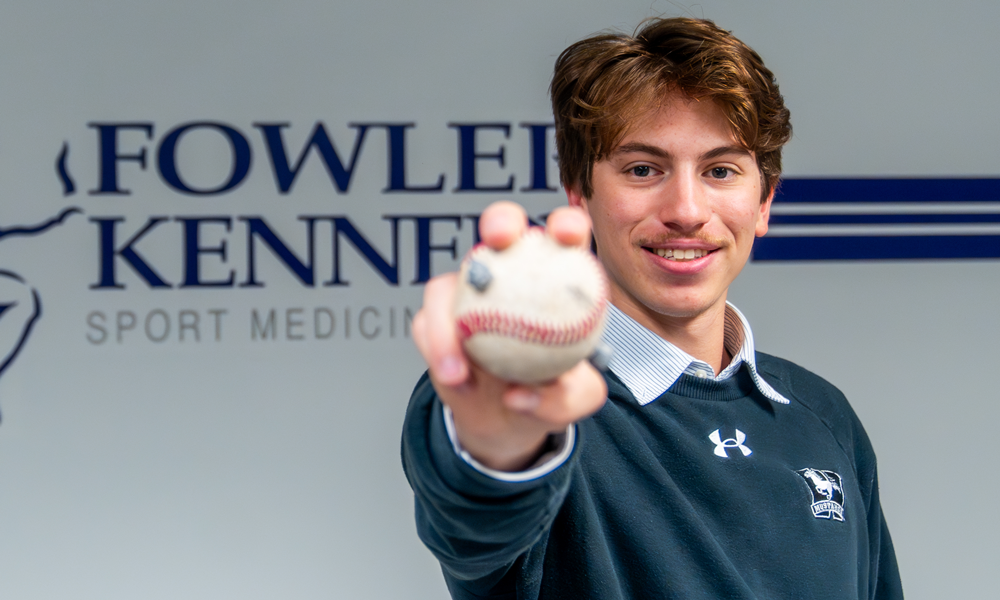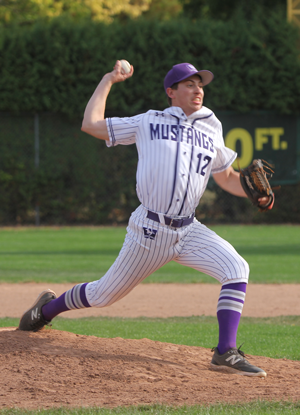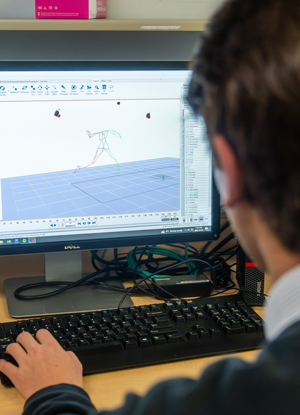Media
Contact
Communications Specialist
Faculty of Engineering
Spencer Engineering Building
Room 2072
Western University
Tel: 519-661-2111 ext. 87015
Email: engineeringcomms@uwo.ca
From the mound to the lab: Engineering student transforms injury into research opportunity

Aaron Austin, a fourth-year Integrated Engineering and Kinesiology student, used motion capture to track pitching fatigue. (photo/Jacob Arts)
When a shoulder injury sidelined Aaron Austin during his junior season as a pitcher for the Western Mustangs baseball team, the fourth-year Integrated Engineering and Kinesiology student found himself with a unique opportunity: to turn personal experience into research that could help prevent similar injuries in other athletes.
"I've always had an interest in sports biomechanics, which led me to pursue a dual degree," said Austin. "But it wasn't until I went through rehab for my shoulder that I was really pushed towards the injury prevention side of research. I wanted to both gain a better understanding of my injury as well as discover better ways to limit similar injuries from happening."
That curiosity led to an Undergraduate Summer Research Award project that has now transitioned into Austin's fourth-year thesis. Working under the supervision of Tom Jenkyn and Emily Lalone, both professors in the department of mechanical and materials engineering, and with external mentorship from Ryan Crotin at Louisiana Tech University, Austin tackled a question with real implications for player safety: how does fatigue systematically affect a pitcher's health and performance?

To answer that question, Austin and research teammate Rhys Jenkyn recruited pitchers from the Western baseball team to throw simulated games at the Wolf Orthopaedic Biomechanics Lab. The holistic approach captured multiple dimensions of fatigue, measuring throwing velocity, arm strength and range of motion alongside detailed biomechanical analysis using motion capture cameras as pitchers accumulated fatigue over the course of a simulated game.
The goal was to develop a better process for detecting fatigue before it pushes athletes toward increased injury risk. By tracking how mechanics change, strength decreases and velocity drops as pitchers tire, the research aims to identify objective indicators that coaches and trainers can use to make safer decisions about when to pull a pitcher from the game.
But translating traditional biomechanics research methods to study full-body athletic movement presented unique challenges. The Wolf Orthopaedic Biomechanics Lab is typically set up to focus on lower body mechanics, examining hips, knees and feet. Austin's project required capturing the complex, dynamic motion of pitching while athletes became progressively fatigued and sweaty.
"My research team and I had to be innovative and become problem solvers, modifying and even DIY-ing data collection methods to suit the needs of our study," Austin said.
One of the most striking findings emerged from observing how athletes self-report their fatigue. Even in a low-pressure lab setting, Austin found that players were inconsistent in recognizing and communicating their bodies' signals. Some athletes reported feeling fine while objective strength tests revealed progressive weakness.
"As both a player and a researcher, I think my perspective is unique," Austin said. "Across all levels of the sport, there are real pressures to continue playing through fatigue to help the team win. If athletes can't always sense or express their own fatigue, it is certainly unfair to expect coaches and trainers to recognize it on their own."
Austin's recommendation focuses on practical tools: coaches and trainers should learn about low-cost methods for measuring strength and range of motion. The research aims to provide the missing piece that complements what coaches observe, giving them objective data to make informed decisions about player safety.

The project represents more than just academic work for Austin. The experience of leading his own study as an undergraduate student has been transformative, teaching him lessons in collaboration, initiative and problem solving that extend far beyond the lab.
"I had always known that I wanted to blend my degrees to work in sport science, but it wasn't until I dove into this project that I had considered that research could be a pathway for me," Austin said. "The study so far has been fulfilling and has opened doors for me to continue this work at the graduate level."
With data collection and analysis still underway, Austin is careful to note that definitive conclusions await further work. But the trends emerging from the research point toward a future where objective biomechanical data helps keep pitchers healthy while maintaining competitive performance.
For Austin, what began as a personal search for answers has evolved into research with the potential to benefit athletes at every level of the game. The experience has also clarified his own path forward, opening doors to continue this work at the graduate level and reinforcing the value of undergraduate research that bridges classroom learning with real-world impact.

